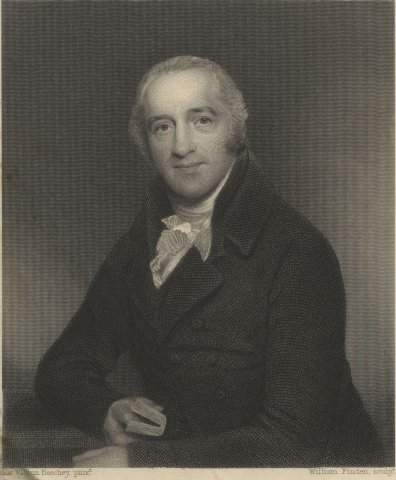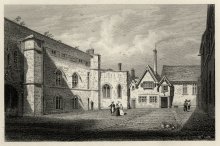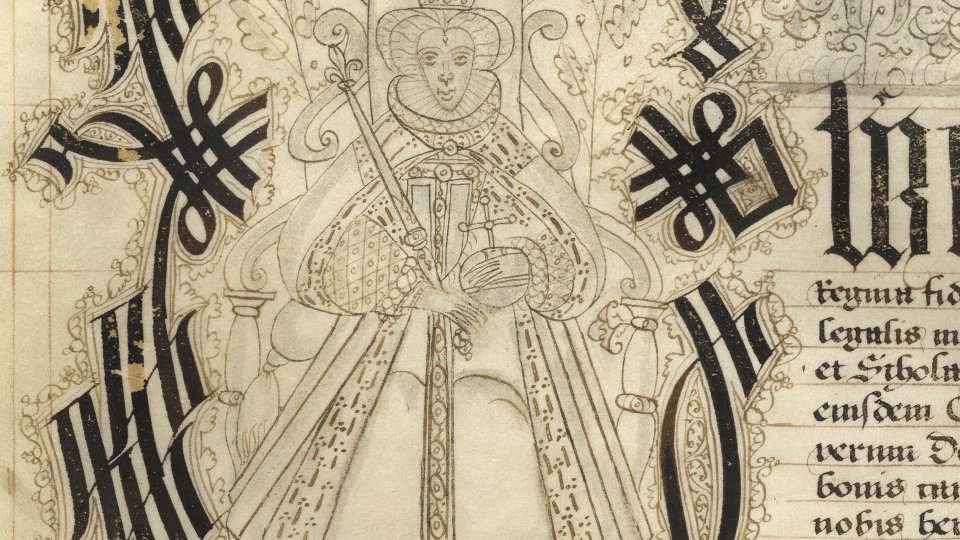
Charles Simeon (1759-1836) was a Kingsman and a Church of England clergyman of extraordinary influence. Young priests training at Cambridge were taught Theology and preaching technique at discussion parties hosted in his College rooms in the Gibbs building. They were inspired by his dynamic preaching at St Edward’s, Great St Mary’s and Holy Trinity churches. They relied upon his published skeletons of sermons when drafting their own. Custance’s map (below) shows sites important in Simeon’s life: (a) King’s College Chapel, (b) Gt St Mary’s, (G) (the one south of the chapel) the Gibbs building with the old bridge on a direct line from under its arch, (i) Holy Trinity Church, and (l) St Edward’s Church.
It was said that his influence and authority extended to the most remote corners of England, and that ‘his real sway over the Church was far greater than that of any Primate’.
His funeral was attended by thousands of Cambridge residents, from the University as well as from the town. On an otherwise lively business day, the shops were closed and classes suspended. The funeral procession was four men wide, it stretched all the way around the front court, and even so there were mourners who could not fit into the Chapel.
Part of Simeon’s legacy is invisible, for example his tireless and successful work to prevent dissenting groups from leaving the Church of England at a time when dissension was rife. More concrete legacies survive in the Church Missionary Society which he co-founded, and the Simeon Trust which now has influence over the nomination of parsons in 143 benefices.
| 24 Sep 1759 | Born |
| 1766 | Admitted to Eton |
| 29 Jan 1779 | Admitted to King's College |
| Apr 1779 | Evangelical conversion at King's College |
| 29 Jan 1782 | Became a King's College Fellow |
| May 1782 | Ordained Deacon, began preaching as volunteer locum at St Edward's |
| Nov 1782 | Appointed curate at Holy Trinity |
| Jan 1783 | Graduated BA |
| Sep 1783 | Ordained Priest |
| 1788 | Beginning of India mission |
| 1789 | 2nd Dean of Arts |
| 1790 | Dean of Divinity |
| 1790 | Started sermon-technique classes |
| 1791-92 | Vice-Provost |
| 1793-94 | 2nd Dean of Arts |
| 1795-97 | 1st Dean of Arts |
| 1797 | Church Missionary Society founded |
| 1798 | Dean of Divinity |
| 1799-1805 | Second Bursar |
| 1812 | Moved to the top room in Gibbs; weekly tea/conversation parties began |
| 1813 | John Thornton died; beginnings of Simeon Trust |
| 1814 | Inherited a family legacy |
| 1821 | New bridge built |
| 1828-30 | 1st Dean of Arts |
| Nov 1836 | Died; funeral and interment in the Chapel |
From our foundation by Henry VI in 1441 until the first change of statutes in 1862, the students and faculty at King’s College – called Scholars and Fellows – were 70 in number. Fellowships were for life, except in certain situations. Each year several young men from Eton were elected as Scholars to fill the places that had been vacated. If they progressed suitably in their studies they were made Fellows, and could remain in College, living off the proceeds of Henry VI’s endowment, until they died, married, or accepted a living as a parish priest elsewhere.
When Simeon came up to King’s from Eton he was an ordinary sort of undergraduate. Like all undergraduates he attended Chapel as required every morning at 8 AM, and twice on Sundays. The eucharist was offered rarely, only a few times a year. When Simeon had to take his first Communion, at Easter, he faced a crisis as he felt profoundly unworthy. Resolution of his conflict came when he realised that the atoning death of Christ gave direct personal access to God, and that Simeon himself had already been forgiven – nothing he did or didn’t do would change that.
In Simeon’s time the College Scholars were superintended by three Deans who were elected annually. The Divinity Dean was not required to preside over Chapel services or to preach, he was to superintend scholastic pursuits in Divinity, Law and Medicine. The two Deans for the Arts did the same for the Arts students. The Divinity Dean was thus more like a modern-day Director of Studies in Theology, Law and Medicine than a modern-day Dean of Chapel. Simeon was elected to one or another of the Deanships on 11 occasions.
The election of officers for 1829 was fraught. A campaign to dethrone Martin Thackeray from the Vice-Provostship caused the election to be postponed twice, and when he was elected anyway his opponents turned against Simeon, who had nominated and supported Thackeray, to keep Simeon from being elected Dean of Arts. After another two postponements Simeon was elected first Dean of Arts. Another two postponements were required before the second Dean of Arts could be elected on January 31, 1829.
Once he was made a Fellow, Simeon hardly ever attended Chapel but he was twice appointed by the Fellows to give the Sermon before the University which occurs in the King’s College Chapel annually, a tradition that continues to the present day. Simeon gave that sermon in 1828 and 1829 - apparently the grudge against Thackeray had to make way for Simeon’s superior preaching.

Simeon was elected Vice-Provost twice. When the Provost is away from College the Vice-Provost is ‘head of house’, with responsibility for discipline, ensuring progress of the Scholars, and managing the staff. Because the Provost made annual circuits of the College estates and was thus away for weeks at a time, this was not a trivial job. By Simeon’s time the Vice-Provost was paid over 44 pounds a year for holding the post.
The payroll sheet reproduced below shows that 10 shillings per quarter were paid to all the senior Fellows, plus 11.1.8 l.s.d. (plus salaries of associated staff) to Simeon for being Vice-Provost, plus the 0.3.4 l.s.d to which all Fellows were entitled once they were ordained priests.
Misbehaving Scholars and Fellows were admonished in proceedings attended by the senior Fellows and Officers, and Simeon was usually present at those proceedings occurring once he was eligible to attend. Common misbehaviours were being disrespectful to other College Members, being lazy, staying out all night, or not attending to studies. Unusual cases during Simeon’s time were a scholar who attacked a creditor in his rooms, and students who took wood from the Old Court buildings (the College moved to its present site beginning in the 1820s – prior to that the College occupied 15th century buildings situated northwest of the Chapel on what is now the Old Schools site) and built a bonfire in the courtyard.
Misbehaviour was usually dealt with by reminding the miscreant of the appropriate statute, confinement to quarters (except for lectures, commons, a bit of exercise, and attending compulsory Chapel) with at most one visitor at a time, and he had to be a Member of College. There was usually invocation of ‘such exercises as shall be appointed them’. One repeat offender did get ‘sent down’ - expelled - in June 1831.
Simeon was elected Second Bursar seven years in a row. That meant he was in charge of collecting rents and administering a third of the College endowment, which was in the form of landed estates. This was a time when England was enclosing open commons land, whereby plots of the newly enclosed land were allotted to local landowners in proportion to the value of their land. One job that fell to Simeon during his Bursarship was to decide how to assign the College allotments in the St Giles enclosure award.
Those allotments were very useful fifty years later when the College successfully negotiated with Clare College to share a cricket pitch across the boundary between the two Colleges. The shared pitch was in use for nearly 40 years until the site was commandeered for the First Eastern Military Hospital, and subsequently the University Library. See the link below for the history of that site.
The University Library was built in the early 1930s and is visible from King’s College, across the river. The University Library, St John’s College Chapel tower, and King’s College Chapel are the tallest buildings in Cambridge.
In Simeon’s day the bridge across the Cam was in the centre of the College site, not quite in a line with the arch of Gibbs’ building. That bridge had been built in 1627. During Simeon’s time as Second Bursar a survey of the old bridge noted that it was not safe. The College voted in 1818 to replace it. Simeon had recently moved into the room at the top of Gibbs’ building, above the arch, from the huge semi-circular window of which he enjoyed the view across the back lawn. He suggested that the view would be much improved if the bridge were situated west of the range of buildings just being erected on the south side of the Front Court. William Wilkins designed the new buildings, as well as the screen along King’s Parade, and Wilkins was chosen to design the bridge. It is the bridge you see there today.
The estimate for building the bridge on the old site was £2250. The builder estimated that building on the new site would cost about £950 more. Simeon paid £700 toward the total cost, which turned out to be a few pounds short of £4000. The bridge was completed in 1821.
The great abolitionist William Wilberforce knew Simeon through what came to be known as the Clapham Sect. Wilberforce said of Simeon that his heart was ‘glowing with love of Christ. How full he is of love, and of desire to promote the spiritual benefit of others. Oh! That I might copy him, as he Christ.’ Simeon showed his love through charitable works, locally and globally, and through advice to students.
During the 1788 corn famine Simeon supported a University subscription programme that enabled bread to be sold at half-price in Cambridge and 24 neighbouring villages, and rode round the town each Monday to make sure the bakers were doing it. In 1795 King’s College Fellows were again occupied with poor relief, at Simeon’s discretion.
Simeon and other members of the Clapham Sect began a missionary group for converted Jews, in 1809, now called the Church’s Ministry Among Jewish People. Though an 1813-15 project to build a Chapel for converted Jews in London failed, Simeon continued for the rest of his life to establish churches for converted Jews throughout Europe and Russia.
Simeon’s was a muscular Christianity. He encouraged his students to study hard and to exercise. He exhorted them to ‘see daily that no one had taken away the third milestone on the Trumpington Road, checking its far side for damage’.
On Trinity Sunday in May 1782, Simeon was ordained. Though not fully priested he could preach and he started doing so immediately, in St Edward’s church which is just across the street from King’s College. He volunteered as a substitute preacher that summer for an Evangelical, Mr Atkinson, whom Simeon felt ‘came nearer to the truth than anyone else I could hear’. He was very popular there.
Simeon’s first appointment was as Perpetual Curate of Holy Trinity Church, against the wishes of the parishioners who had promised the living to the existing curate. They wrote their intentions to the Bishop but in so doing managed to irritate him so that he would not ‘under any circumstances’ have allowed the incumbent to stay, and thus Simeon was set up in his first parish in unwelcoming circumstances. He gave the weekday Lectureship to the incumbent and thus could only preach once a week, and when he did he initially met great resistance in the form of locked doors and boycotts of his sermons.
The tables began to turn when he gave his first University sermon, at the University Church of Great St Mary’s in December, 1786. Many academics attended in order to disrupt his sermon but they all left subdued and impressed, and after that the Holy Trinity parishioners lost ground. Simeon preached often at Great St Mary’s, and to great effect. He preached from notes like the ones shown here and came home afterwards to record what he said, which he claimed helped him to gain ‘accuracy – conciseness – life – spirit’. During his final years it was standing room only when Simeon preached.
Simeon felt there were gaps in the University’s training of priests. To fill those gaps he held discussion parties on Theology, and sermon classes which provided practical notes on delivery techniques as well as material suitable for sermons. He supplemented these popular weekly get-togethers with practical exposition when he preached at Great St Mary’s and Holy Trinity, and by publishing 21 books of partial or skeleton sermons, called Horae Homileticae. They were organised by the chapter of the Bible they elucidate. These skeletons were widely used by Anglican priests around the world, and were very popular even after they went out of print.
Simeon improved the quality of pastoral care in many parishes by using money that he had inherited and/or been entrusted with to buy Church of England advowsons – the right to name the parson – and fill the posts with Evangelical priests. This abolished long-standing sinecures and prevented nepotistic promotion of lacklustre ministers. Through this Simeon Trust (now Simeon’s Trustees) he required his trustees to elect to each vacancy a ‘truly pious and devoted man, a man of God in deed and in truth…[with] solid judgement and a perfectly independent mind…consult[ing] nothing but the welfare of the people for whom they are to provide…suited to the particular parish’. At Simeon’s death the Trust owned 21 advowsons; Simeon’s Trustees currently own or have influence over nominations in 143 benefices. The churches in which these appointees preside are called Simeon Churches.
Simeon inspired, advised and supported missionaries such as Henry Martyn in the Near East and Samuel Marsden in New Zealand. Together with like-minded Evangelicals he was a founding member of the Church Missionary Society.
Henry Martyn (1781-1812) was a very bright student who came up to St John’s College, Cambridge where he was impressed and moved by Simeon’s preaching. They became friends and Martyn was so inspired that he became a missionary to India in 1806, where he worked on translations of the Bible into Arabic, Persian and Urdu. From 1810 until his unfortunate early death he travelled in the Near East. He kept in contact with Simeon but struggled against tuberculosis that eventually took his life.
In its bicentennial year (1999) the CMS organised a walk from Oxford to Cambridge to raise funds to support schools for camel-based nomads in northern Kenya. It was particularly appropriate that the walkers were met by dignitaries at the Gibbs arch, directly beneath Simeon’s old rooms.
-
Austen Leigh, Augustus: Cambridge University College Histories: King’s (London: FE Robinson & Co., 1899).
-
Cooper, Charles Henry: Memorials of Cambridge vols. 1 (1860) and 3 (1866) (Cambridge: William Metcalfe).
-
Harrison, Ross: ‘The Start and Stop of Simeon’. In King's College Chapel 1515-2015. Art, Music and Religion in Cambridge, ed. Jean Michel Massing and Nicolette Zeeman (London: Harvey Miller, 2014), pp 221-237.
-
Murphy, Rev. Prebendary F.E.: ‘Simeon and Patronage’. In Charles Simeon, an Interpretation, Centenary addresses delivered at Cambridge. (London: Lutterworth Press, 1936).
-
Oxford Dictionary of National Biography On-Line.
-
Simeon, Charles: Memoirs of the Rev. Charles Simeon, ed. Rev William Carus (London: Hatchard & Son, 1847).
